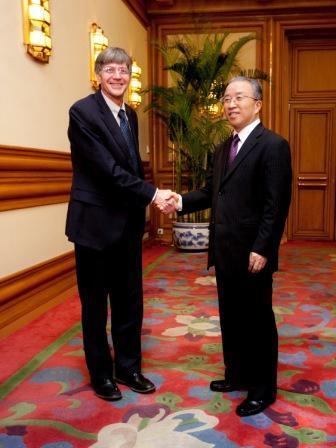North Korea likely has at least one secret nuclear facility, in addition to a plant at Yongbyon whose existence was reported last year, according to diplomats who have read a confidential United Nations report.
A UN panel of nuclear experts also said in the report that North Korea is receiving technical assistance from visiting foreign scientists, according to the diplomats who described the findings and asked not to be identified because the report hasn’t been made public. The panel reached its conclusions during a two-month investigation of the Yongbyon facility.
The Yongbyon plant’s existence was disclosed following the North Korean government-authorized visit of Siegfried Hecker, a professor at Stanford University in California.
The report, commissioned by the UN Security Council committee to implement sanctions against North Korea, says it’s likely that centrifuges and other equipment in the Yongbyon reactor were previously operating at one or more secret locations, according to the diplomats.
They said the report also cites evidence that foreign scientists visiting North Korea contributed their expertise to construction of the plant. No country of origin was identified.
The Security Council sanctions committee requested the report after a briefing by Hecker on Dec. 6. The panel of experts, appointed by the council last year to assess sanctions intended to block North Korea’s development of nuclear weapons and ballistic missiles, didn’t visit the facility. They relied on Hecker’s impressions and input from Japanese and South Korean government officials and other nuclear energy experts.
Security Council Resolutions
While saying he couldn’t comment on a confidential report, Mark Kornblau, a spokesman for the U.S. mission to the UN, said North Korea’s uranium enrichment program violates UN Security resolutions 1718 and 1874. Also, he said in an e-mailed statement, the program “is inconsistent with North Korea’s previous commitments, and compels tighter enforcement of existing sanctions.”
The facility at Yongbyon is intended to provide low- enriched uranium for a light-water reactor for the “peaceful purpose of meeting electricity demand,” the official Korean Central News Agency said on Nov. 30. It was the first time North Korea acknowledged the program, revealed by Hecker on Nov. 20 following his visit.
It’s unlikely that North Korea manufactured the equipment needed to build the facility, Hecker told the panel. It is more likely that North Korea imported some of the materials, assembled parts of the facility at other locations over many years, and transferred them to Yongbyon, he said.
The report makes 10 recommendations, including designating additional North Korean nuclear officials for a travel ban and foreign-asset freeze.
 |
Dai Bingguo, China's State Councilor, right, shakes hands with U.S. Deputy Secretary of State James Steinberg. South Korea proposed military talks with North Korea for Feb. 11 as Kim Jong Il's regime renewed calls for unconditional dialogue to ease tensions heightened since its November shelling of a South Korean island. (Bloomberg-Yonhap News) |
<한글 기사>
"北, 영변외 핵시설 더 있다"
전문가 패널 보고서 결론 "우라늄 농축 1990년대 이미 시작"
유엔 전문가 패널은 북한이 지난해 공개한 영변 핵시설 외 추가 시설을 보유한 것으로 결론지었다고 유엔 안전보장이사회 외교관들이 31일(현지시각) 밝혔다.
외교관들에 따르면 패널은 지난해 방북 당시 원심분리기를 비롯한 핵시설을 확인했다고 밝힌 지그프리드 헤커 스탠퍼드대 교수의 전언과 자체 조사, 분석 등을 토 대로 최근 이같은 내용의 비밀 보고서를 작성했다.
이들 추가 시설에 관한 세부 정보는 확인되지 않았다.
보고서는 또 북한의 우라늄 농축작업이 지난 2009년부터가 아닌 1990년대 이미 시작된 것으로 판단했다고 외교관들은 전했다.
보고서는 핵개발 관련 제재 대상 기업 명단에 북한 업체들을 추가로 포함시키고 핵개발 업무를 담당하는 북한 관리들을 여행금지 대상 명단에 추가하는 등 10개항에 이르는 권고안을 내놨다.
유엔 안보리는 헤커 박사의 방북 결과 브리핑 직후인 지난해 12월 북한 핵무기 와 탄도미사일 개발 현황을 분석할 전문가 패널을 지명하고 이들에게 보고서 작성을 의뢰한 바 있다.
패널에는 한국을 비롯, 영국과 중국, 프랑스, 일본, 러시아, 미국 측 대표들이 포함됐다.
(연합뉴스)







![[Today’s K-pop] Blackpink’s Jennie, Lisa invited to Coachella as solo acts](http://res.heraldm.com/phpwas/restmb_idxmake.php?idx=644&simg=/content/image/2024/11/21/20241121050099_0.jpg)